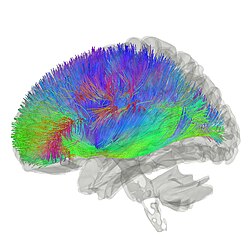
Back جسم مخطط Arabic Strijatum BS Nucli estriat Catalan Striatum Czech Striatum German Cuerpo estriado Spanish Gorputz ildaskatu Basque جسم مخطط Persian Aivojuovio Finnish Striatum French
| Striatum | |
|---|---|
 Striatum shown in green with other basal ganglia and thalamus. Small region in yellow is the amygdala | |
 Tractography showing corticostriatal connections | |
| Details | |
| Part of | Basal ganglia[1] Reward system[2][3] |
| Parts | Ventral striatum[2][3][4] Dorsal striatum[2][3][4] |
| Identifiers | |
| Latin | striatum |
| MeSH | D003342 |
| NeuroNames | 225 |
| NeuroLex ID | birnlex_1672 |
| TA98 | A14.1.09.516 A14.1.09.515 |
| TA2 | 5559 |
| FMA | 77616 77618, 77616 |
| Anatomical terms of neuroanatomy | |
The striatum (pl.: striata) or corpus striatum[5] is a cluster of interconnected nuclei that make up the largest structure of the subcortical basal ganglia.[6] The striatum is a critical component of the motor and reward systems; receives glutamatergic and dopaminergic inputs from different sources; and serves as the primary input to the rest of the basal ganglia.
Functionally, the striatum coordinates multiple aspects of cognition, including both motor and action planning, decision-making, motivation, reinforcement, and reward perception.[2][3][4] The striatum is made up of the caudate nucleus and the lentiform nucleus.[7][8] However, some authors believe it is made up of caudate nucleus, putamen, and ventral striatum.[9] The lentiform nucleus is made up of the larger putamen, and the smaller globus pallidus.[10] Strictly speaking the globus pallidus is part of the striatum. It is common practice, however, to implicitly exclude the globus pallidus when referring to striatal structures.
In primates, the striatum is divided into the ventral striatum and the dorsal striatum, subdivisions that are based upon function and connections. The ventral striatum consists of the nucleus accumbens and the olfactory tubercle. The dorsal striatum consists of the caudate nucleus and the putamen. A white matter nerve tract (the internal capsule) in the dorsal striatum separates the caudate nucleus and the putamen.[4] Anatomically, the term striatum describes its striped (striated) appearance of grey-and-white matter.[11]
- ^ "Basal ganglia". BrainInfo. Retrieved 16 August 2015.
- ^ a b c d Cite error: The named reference
YAGER2015was invoked but never defined (see the help page). - ^ a b c d Taylor SB, Lewis CR, Olive MF (February 2013). "The neurocircuitry of illicit psychostimulant addiction: acute and chronic effects in humans". Subst. Abuse Rehabil. 4: 29–43. doi:10.2147/SAR.S39684. PMC 3931688. PMID 24648786.
The DS (also referred to as the caudate-putamen in primates) is associated with transitions from goal-directed to habitual drug use, due in part to its role in stimulus–response learning.28,46 As described above, the initial rewarding and reinforcing effects of drugs of abuse are mediated by increases in extracellular DA in the NAc shell, and after continued drug use in the NAc core.47,48 After prolonged drug use, drug-associated cues produce increases in extracellular DA levels in the DS and not in the NAc.49 This lends to the notion that a shift in the relative engagement from the ventral to the dorsal striatum underlies the progression from initial, voluntary drug use to habitual and compulsive drug use.28 In addition to DA, recent evidence indicates that glutamatergic transmission in the DS is important for drug-induced adaptations and plasticity within the DS.50
- ^ a b c d Cite error: The named reference
FERRE2010was invoked but never defined (see the help page). - ^ "striatum | Definition of striatum in English by Oxford Dictionaries". Oxford Dictionaries | English. Archived from the original on 18 January 2018. Retrieved 17 January 2018.
- ^ Bamford IJ, Bamford NS (October 2019). "The Striatum's Role in Executing Rational and Irrational Economic Behaviors". Neuroscientist. 25 (5): 475–490. doi:10.1177/1073858418824256. PMC 6656632. PMID 30678530.
- ^ Jones, Jeremy. "Corpus striatum | Radiology Reference Article | Radiopaedia.org". radiopaedia.org. Retrieved 17 January 2018.
- ^ "Corpus striatum". BrainInfo. Retrieved 16 August 2015.
- ^ Báez-Mendoza, Raymundo; Schultz, Wolfram (10 December 2013). "The role of the striatum in social behavior". Frontiers in Neuroscience. 7: 233. doi:10.3389/fnins.2013.00233. ISSN 1662-4548. PMC 3857563. PMID 24339801.
- ^ Telford, Ryan; Vattoth, Surjith (February 2014). "MR Anatomy of Deep Brain Nuclei with Special Reference to Specific Diseases and Deep Brain Stimulation Localization". The Neuroradiology Journal. 27 (1): 29–43. doi:10.15274/NRJ-2014-10004. PMC 4202840. PMID 24571832.
- ^ "Striatum definition and meaning | Collins English Dictionary". www.collinsdictionary.com.